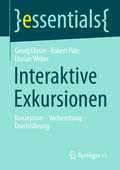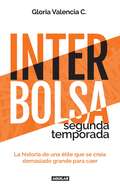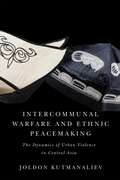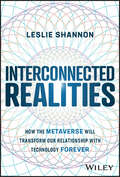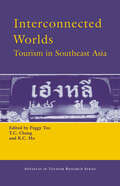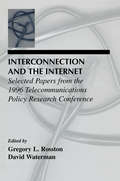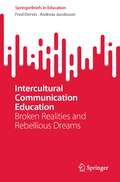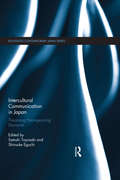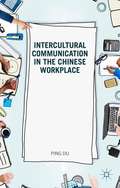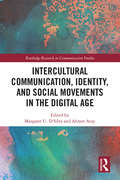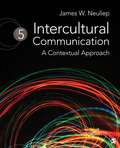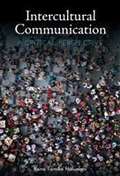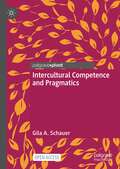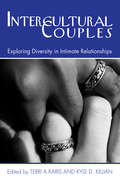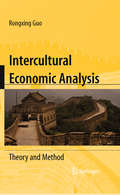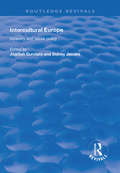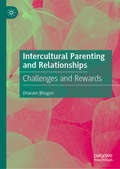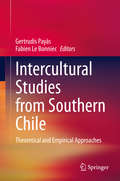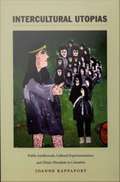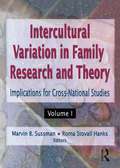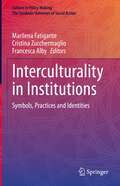- Table View
- List View
Interaktive Exkursionen: Konzeption – Vorbereitung – Durchführung (essentials)
by Florian Weber Georg Glasze Robert PützIn diesem essential wird praxisorientiert dargestellt, wie interaktive Exkursionen im Hochschulkontext von Studierenden vorbereitet und moderiert werden können. Ausgangspunkt bildet der Ansatz eines „lehrenden Lernens“, bei dem die Studierenden zu Expert*innen für einzelne Themenbereiche werden. Kern des Konzepts sind exkursionsdidaktische Drehbücher, die von Kleingruppen ausgearbeitet werden. Mit Tipps zur Wahl von Standorten, zur Exkursionsleitung und zur interaktiven Gestaltung von einzelnen Exkursionsblöcken stellt das essential die „Werkzeuge“ vor, die für eine erfolgreiche Gestaltung von Exkursionen notwendig sind.
Interbolsa segunda temporada
by Gloria ValenciaLa periodista ganadora del Premio de periodismo Simón Bolívar regresa para revelarla segunda parte de uno de los desfalcos financieros más grandes de la historia reciente de Colombia. <P><P>Han pasado cinco años desde el derrumbe de InterBolsa, la otrora comisionista más grande del sector en Colombia. <P><P>Desde entonces, Gloria Valencia, quien recibió el Premio Simón Bolívar a mejor libro periodístico por su trabajo sobre este tema, le ha seguido el rastro al caso de manera rigurosa e ininterrumpida. <P><P> En este libro la autora se vuelca de nuevo sobre la investigación y sobre los expedientes judiciales; retoma sus fuentes en la Fiscalía, las conversaciones y entrevistas con personas cercanas al proceso, para revelar en estas nuevas páginas el estado actual del caso, los alcances de la justicia, la reparación a las víctimas y el castigo a los responsables. <P><P> InterBolsa, segunda temporada se convertirá en un documento de memoria histórica sobre uno de los descalabros financieros más grandes en los últimos años en Colombia, y en un libro de estudio para generaciones actuales y venideras.
Intercommunal Warfare and Ethnic Peacemaking: The Dynamics of Urban Violence in Central Asia (McGill-Queen's Studies in Protest, Power, and Resistance)
by Joldon KutmanalievWith increasing urban population density, conflicts in cities erupt more frequently and violently. Cities have become hotspots for armed combat, highlighting the urgency of understanding the impact of local communities and urban factors on the development of violent conflict. Joldon Kutmanaliev presents a novel approach to analyzing communal violence and armed conflicts in urban zones. Drawing from fieldwork in cities of southern Kyrgyzstan, he explains local-level variations in violence across neighbourhoods during the most intense and violent episode of urban communal violence in Central Asia – the clashes between Kyrgyz and Uzbeks in June 2010. Kutmanaliev explains why armed violence affects some urban neighbourhoods but not others, why local communities react differently to the same existential threat, how they deal with a deteriorating security environment and interethnic fears, and how different types of urban planning and urban landscapes influence the spread of violence. Importantly, the book identifies key factors that help local communities and their leaders to negotiate non-aggression pacts and control local constituencies, and therefore successfully prevent violence.Intercommunal Warfare and Ethnic Peacemaking explains communal war and ethnic peacemaking on the level of neighbourhood communities – a perspective that is largely absent in previous studies.
Interconnected Realities: How the Metaverse Will Transform Our Relationship to Technology Forever
by Leslie ShannonExplore how the metaverse is changing our livesIn Interconnected Realities, Leslie Shannon, Head of Trend and Innovation Scouting at Nokia, delivers an energizing and optimistic new take on the Metaverse. Starting with metaverse realms already in existence today, the book explores the purpose that each independent platform serves, as well as how all these disparate realms will ultimately be stitched together to permanently transform our personal and business lives. A singularly insightful and informed exploration of a fascinating subject at the intersection of technology, business, and society, Interconnected Realities is an essential resource for executives, managers, board members, and other business leaders at companies in a wide range of industries, as well as tech enthusiasts, futurists, and anyone with an interest in the future of social interaction, business, or technology.
Interconnected Worlds: Tourism In Southeast Asia
by K.C. HoExamines the political discourse behind tourism, presenting some questions regarding the tensions associated with the interconnections. This title focuses on deterritorialisation and the development of fresh regionalisms, paying specific attention to collaborative efforts in tourism development.
Interconnection and the Internet: Selected Papers From the 1996 Telecommunications Policy Research Conference (LEA Telecommunications Series)
by Christopher H. Sterling David Waterman Gregory L. RosstonThe Telecommunications Act of 1996 and the Federal Communications Commission's Local Competition Order are just two examples of the continuing monumental and far-reaching changes occurring throughout the telecommunications industry. At the 1996 Telecommunications Policy Research Conference (TPRC) -- an annual forum for dialogue among scholars and the policymaking community on a wide range of telecommunications issues -- leading industry and academic researchers presented results of their research and insights in key areas of activity, including: *interconnection and competition; *Internet growth and commerce; *Internet regulation and control; and *the political economy of telecommunications regulation. The best of the 1996 TPRC papers are included here, representing the forefront of research in the telecommunications industry. The third in an annual LEA series of volumes based on this important conference, this collection reflects the rapid economic, technological, and social development of telecommunications. It also reflects the current state of research thinking on this issue and provides a foundation for further telecommunications policy analysis.
Intercultural Communication Education: Broken Realities and Rebellious Dreams (SpringerBriefs in Education)
by Fred Dervin Andreas JacobssonThis book explores the notion of interculturality in education and supports scholars in their discovery of the notion. Continuing the author’s previous work, the book urges (communication) education researchers and educators to 'interculturalize' interculturality. This book corresponds to the authors’ endeavor to complexify the way interculturality is discussed, expressed, (co-)constructed and advocated in different parts of the world and in different languages. To interculturalize interculturality is to expand the way we deal with the notion as an object of scientific and educational discourse, noting the dominating voices and allowing for silenced voices that are rarely heard around interculturality to emerge. This book is based on broken realities and (the authors’) rebellious dreams. As two researchers and educators with a long experience examining discourses of interculturality, this book represents the authors’ program for the future of intercultural communication education. The book is divided into three 'tableaus' (living descriptions) depicting today’s 'broken' realities of interculturality and two 'rebellious' dreams of what it could be in research and education.
Intercultural Communication in Japan: Theorizing Homogenizing Discourse (Routledge Contemporary Japan Series)
by Satoshi Toyosaki Shinsuke EguchiJapan is heterogeneous and culturally diverse, both historically through ancient waves of immigration and in recent years due to its foreign relations and internationalization. However, Japan has socially, culturally, politically, and intellectually constructed a distinct and homogeneous identity. More recently, this identity construction has been rightfully questioned and challenged by Japan’s culturally diverse groups. This book explores the discursive systems of cultural identities that regenerate the illusion of Japan as a homogeneous nation. Contributors from a variety of disciplines and methodological approaches investigate the ways in which Japan’s homogenizing discourses are challenged and modified by counter-homogeneous message systems. They examine the discursive push-and-pull between homogenizing and heterogenizing vectors, found in domestic and transnational contexts and mobilized by various identity politics, such as gender, sexuality, ethnicity, foreign status, nationality, multiculturalism, and internationalization. After offering a careful and critical analysis, the book calls for a complicating of Japan’s homogenizing discourses in nuanced and contextual ways, with an explicit goal of working towards a culturally diverse Japan. Taking a critical intercultural communication perspective, this book will be of interest to students and scholars of Japanese Studies, Japanese Culture and Japanese Society.
Intercultural Communication in the Chinese Workplace
by Ping DuChina's sharp economic growth at the beginning of the twenty-first century has resulted in an increasing number of people from the other countries moving to work in China. This inevitably highlights the cultural differences that are apparent between China and other global workplace cultures. This book proposes a new theoretical and methodological approach to the investigation and explanation of intercultural differences in conflict management strategies and relational (politeness) strategies in workplace settings, taking the Chinese workplace as its focus. Drawing upon social psychology, sociolinguistics and discourse analysis, the book analyses various types of data such as recordings of meetings, participant interviews, organizational documents and emails to offer a new research approach that has relevance for researchers and scholars of intercultural communication globally.
Intercultural Communication, Identity, and Social Movements in the Digital Age (Routledge Research in Communication Studies)
by Ahmet Atay Margaret U. D’SilvaThis book examines the complex and multidimensional relationship between culture and social media, and its specific impact on issues of identity and social movements, in a globalized world. Contemporary cyber culture involves communication among people who are culturally, nationally, and linguistically similar or radically different. Social media becomes a space for mediated cultural information transfer which can either facilitate a vibrant public sphere or create cultural and social cleavages. Contributors of the book come from diverse cultural backgrounds to provide a comprehensive analysis of how these social media exchanges allow members of traditionally oppressed groups find their voices, cultivate communities, and construct their cultural identities in multiple ways. This book will be of great relevance to scholars and students working in the field of media and new media studies, intercultural communication, especially critical intercultural communication, and academics studying social identity and social movements.
Intercultural Communication, Identity, and Social Movements in the Digital Age (Routledge Research in Communication Studies)
by Margaret U. D’Silva; Ahmet AtayThis book examines the complex and multidimensional relationship between culture and social media, and its specific impact on issues of identity and social movements, in a globalized world. Contemporary cyber culture involves communication among people who are culturally, nationally, and linguistically similar or radically different. Social media becomes a space for mediated cultural information transfer which can either facilitate a vibrant public sphere or create cultural and social cleavages. Contributors of the book come from diverse cultural backgrounds to provide a comprehensive analysis of how these social media exchanges allow members of traditionally oppressed groups find their voices, cultivate communities, and construct their cultural identities in multiple ways.This book will be of great relevance to scholars and students working in the field of media and new media studies, intercultural communication, especially critical intercultural communication, and academics studying social identity and social movements.
Intercultural Communication: A Contextual Approach (5th Edition)
by James W. NeuliepBased on the contextual model of intercultural communication, this text for a first undergraduate course features examples from an amazing variety of cultures, including Hmong, Amish, Navajo, and Arab American, as well as Latino, African American, and Japanese. The text introduces the need for intercultural communication, then covers cultural, micro-cultural, environmental, perceptual, and socio-relational contexts. There is also material on verbal and nonverbal codes, developing intercultural relationships, intercultural conflict, and intercultural communication in organizations. Learning features include discussion questions, self-assessments to assess student attitudes, and boxes offering student voices across cultures (new to this edition). This fifth edition offers several other new features: ethics questions, discussion of lesbian and gay culture, and a focus on the role of modern communication technology. Neuliep is affiliated with St. Norbert College. Annotation ©2012 Book News, Inc. , Portland, OR (booknews. com)
Intercultural Communication: A Critical Perspective
by Rona HalualaniWritten to encourage deeper understanding of and an active role in intercultural justice, Intercultural Communication: A Critical Perspective provides students with an in-depth examination of contemporary intercultural communication through the lens of power. Through this unique perspective, the book demonstrates how micro communication acts, encounters, and relationships between and within cultural groups can influence and be influenced by macro structures, organizations, and forces - and vice versa. <P><P>The book begins by introducing the concept of intercultural communication and demonstrating how ubiquitous it is in our everyday lives. Subsequent chapters address the ties between culture, power, and intercultural communication; how powerful ideologies develop from cultural views and ways of life; and the interplay of cultural representation and speaking for or about a cultural group. Readers learn the ways in which individuals and structures of power shape identity, how different structures and groups remember and forget the past, and how racialization relates to intercultural communication. The final chapters explore power dynamics with regard to globalization, intercultural relationships and desire, and our roles in intercultural communication.
Intercultural Competence and Pragmatics
by Gila A. SchauerThis Open Access book examines the link between intercultural competence (IC) and pragmatics by asking frontline modern foreign language teachers in higher education teaching a variety of languages (e.g., Dutch, English, French, German, Italian, Spanish, Swedish) how they conceptualise intercultural competence and which skills, competences and knowledge they consider important in their teaching contexts. The data were collected with an online survey that focused on the relationship between intercultural competence and pragmatics.While international organizations such as the United Nations Educational, Scientific and Cultural Organization (UNESCO) or the Council of Europe (CoE) agree that intercultural competence should play an important role in education, it is not always clear what IC may encompass in specific teaching contexts and subject areas. Examining how modern foreign language teachers in higher education conceptualise intercultural competence and the value they attach as well as the attention they give to various areas of pragmatics in their teaching is highly important, since those language professionals may be the final teachers learners encounter during their formal foreign language education. They are therefore in a unique position to shape modern foreign language learners’ intercultural and pragmatic awareness, competence and skills.This book will be of interest to language professionals, modern foreign language teachers and teacher trainers, as well as students and scholars of applied linguistics, pragmatics, and language education.
Intercultural Couples: Crossing Boundaries, Negotiating Difference
by Jill M. BystydzienskiDespite the growing presence of intercultural couples in the United States and worldwide, their stories often go untold. In Intercultural Couples, Jill Bystydzienski provides a rare and comprehensive understanding of the multidimensional experiences of intercultural couples, drawing mainly upon in-depth interviews with persons living in domestic partnerships—heterosexual and same-sex—representing a broad spectrum of ethnic, racial, religious, socioeconomic, and national backgrounds. In these relationships, each partner brings a different set of cultural experiences that may include gender expectations, ideas about appropriate relations with family members, childrearing, financial matters, and general lifestyle. Sometimes differences may be unrecognized or seen as minimal, yet some can become salient, forming the basis for conflict, enriching diversity, or both. Bystydzienski’s findings show that, despite hurtful incidents from persons outside the couple partnerships, intercultural unions are a source of satisfaction for the partners, and are able to bridge divisions and reduce inequalities between persons of diverse backgrounds, providing a rich portrait of how these couples negotiate their identities as individuals and as couples in relation to the outside world.
Intercultural Couples: Exploring Diversity in Intimate Relationships
by Kyle D. Killian Terri A. KarisWhile cross-cultural relations were once assumed to be inherently problematic, in recent years these couples have increased in both numbers and social acceptance, and there is now a growing awareness of how little we really know about them. Addressing this gap in our knowledge, this book presents 12 chapters focusing on cross-cultural couple formations (i.e., a partner from the U.S. and another from abroad). Highlighting both the struggles and successes of couples, this book challenges the principle of homogamy, helping the reader gain a deeper understanding and respect for intercultural couples. The chapters tackle a broad range of topics and issues, including systemic considerations of the phenomenon of cross-cultural couples, bilingual couples, interfaith relationships, struggles in such couple formations, different methods of approaching solutions, and the use of the internet to meet partners from diverse backgrounds.
Intercultural Economic Analysis
by Rongxing GuoSince the end of the Cold War, the study of intercultural relations has become one of the most popular topics in the field of global politics and economics. This book presents a methodological framework for the analysis of intercultural issues frequently misinterpreted by existing theories. The book uses a challenge-and-response theory of cultural development to examine the relationship between different natural disasters and threats and the developments of ancient civilizations. The spatial interaction of ancient civilizations is assessed and some theoretical patterns of intercultural influences are presented with a focus on the Chinese, Egyptian, Indus, and Mesopotamian civilizations. Using the development of China as a case study, and on the basis of a simplified spatial model, the optimal spatial structure and size of culture areas are mathematically solved, and the political economy implications to the interactions between cultures differing in size are illustrated. The book also examines various aspects of intercultural economic influences, such as those of culture on international trade. The empirical results suggest that high-income trade partners are less sensitive than low-income trade partners to the measures of cultural dissimilarity which block international trade. The existing literature relating to the determinants of economic growth treats explanatory variables such as income inequality and cultural diversity separately. This book investigates whether there are any conditions under which income inequality and cultural diversity could encourage economic growth and provides evidence from a broad panel of nations, which reveals that economic growth is quite independent from the variables of inequality and cultural (linguistic and religious) diversity. Finally, this book provides suggestions for how cultural influences can benefit developing economies both large and small.
Intercultural Education: Theories, Policies and Practices (Routledge Revivals)
by Giovanna Campani Gajendra K. Verma Christopher Bagley Derek Woodrow Maria Beatriz Rocha-TrindadePublished in 1997, this volume is a result of a number of European Union and Council of Europe initiatives. The major stimulus came from an intensive course held in Lisbon in 1994 as part of two Erasmus networks exploring the nature of intercultural studies on a European-wide basis. Although the concepts of multiculturalism and interculturalism have frequently been discussed within a British context, this book draws on the interlocking and comparative persectives of specialists in education and teacher training in several European countries including Spain, France, Italy, Britain and the Netherlands. Educational policies and theories of identity are compared and there are special sections in multilinguism, teacher training, curriculum development, relationships between different ethnic groups and a vision of the future of intercultural education in Europe. The issues discussed in the book are significant in the development of modern societies as they seek to come to terms with the revolution in intercultural relations brought about by mass communications and global transport. The world is rapidly having to come to terms with cultural and social differences which can no longer be kept separate in their protective groups.
Intercultural Europe: Diversity and Social Policy
by Jagdish Gundara Sydney JacobsThis title was first published in 2000: The essays in this text examine interculturalism in Europe, focusing on social diversity and social policy within the European Union. Issues addressed include racism and social policy, migrant communities in Europe, ethnic diversity, intercultural education and housing and segregation.
Intercultural Parenting and Relationships: Challenges and Rewards
by Dharam BhugunThis book provides understandings of how intercultural, -racial, -ethnic, -national, and -faith couples and parents in Australia bring up their children and manage their relationships. Which challenges and benefits do they encounter, and which strategies do they use to negotiate their differences and belongingness? In portraying the lived experiences of intercultural couples and parents, Bhugun considers contextual and external factors such as individual and personality traits, the environment, gender and power, religion, socio-economic status, extended family, friends, and diasporic communities. Moving the reader from beyond negative stereotypes to a more nuanced representation of both the challenges and benefits of the phenomenon, Intercultural Parenting and Relationships provides intimate testimonies and offers innovations in theory and practice.Scholars, practitioners, students, intercultural couples, parents, families and the wider community will benefit from the rich insights into the challenges and successes of intercultural relationships and parenting presented in this book.
Intercultural Studies from Southern Chile: Theoretical and Empirical Approaches
by Gertrudis Payàs Fabien Le BonniecThis book presents a multidisciplinary overview of a little known interethnic conflict in the southernmost part of the Americas: the tensions between the Mapuche indigenous people and the settlers of European descent in the Araucania region, in southern Chile. Politically autonomous during the colonial period, the Mapuche had their land confiscated, their population decimated and the survivors displaced and relocated as marginalized and poor peasants by Chilean white settlers at the end of the nineteenth century, when Araucania was transformed in a multi-ethnic region marked by numerous tensions between the marginalized indigenous population and the dominant Chileans of European descent.This contributed volume presents a collection of papers which delve into some of the intercultural dilemmas posed by these complex interethnic relations. These papers were originally published in Spanish and French and provide a sample of the research activities of the Núcleo de Estudios Interétnicos e Interculturales (NEII) at the Universidad Católica de Temuco, in the capital of Araucania. The NEII research center brings together scholars from different fields: sociocultural anthropology, sociolinguistics, ethno-literature, intercultural education, intercultural philosophy, ethno-history and translation studies to produce innovative research in intercultural and interethnic relations. The chapters in this volume present a sample of this work, focusing on three main topics: The ambivalence between the inclusion and exclusion of indigenous peoples in processes of nation-building.The challenges posed by the incorporation of intercultural practices in the spheres of language, education and justice.The limitations of a functional notion of interculturality based on eurocentric thought and neoliberal economic rationality. Intercultural Studies from Southern Chile: Theoretical and Empirical Approaches will be of interest to anthropologists, linguists, historians, philosophers, educators and a range of other social scientists interested in intercultural and interethnic studies.
Intercultural Thinking in African Philosophy: A Critical Dialogue with Kant and Foucault (Routledge Studies in African Philosophy)
by Marita RainsboroughThis book sets up a rich intercultural dialogue between the philosophy of Immanuel Kant and Michel Foucault, and that of key African thinkers such as Kwame Anthony Appiah, Achille Mbembe, Kwasi Wiredu, Kwame Gyekye, Tsenay Serequeberhahn, and Henry Odera Oruka.The book challenges western-centric visions of an African future by demonstrating the richness of thought that can be found in African and Afrodiasporic philosophy. The book shows how thinkers such as Serequeberhan have criticised the inconsistencies in Kant’s work, whereas others such as Wiredu, Gyekye, Appiah and Mbembe have referenced his work more positively and developed progressive political concepts such as the metanational state; partial cosmopolitanism and Afropolitanism. The book goes on to consider how Mbembe and Mudimbe have responded to Foucault’s ideas in deciphering the various Western, African and Afrodiasporic discourses of knowledge on Africa. The book concludes by considering various theories of intercultural exchange, from Gyekye’s cultural borrowing, to Appiah’s conversation across boundaries, Wiredu’s cross cultural dialogue, Mbembe’s thinking outside the frame, Serequeberhan’s dialogue at a distance, and Oruka’s call for global re-distribution and a new ecophilosophical attitude to safeguard human existence on the planet.This book invites us all to engage in intercultural dialogue and mutual respect for different cultural creations. It will be an important read for researchers in Philosophy wherever they are in the world.
Intercultural Utopias: Public Intellectuals, Cultural Experimentation, and Ethnic Pluralism in Colombia
by Joanne RappaportAlthough only 2 percent of Colombia's population identifies as indigenous, that figure belies the significance of the country's indigenous movement. More than a quarter of the Colombian national territory belongs to indigenous groups, and 80 percent of the country's mineral resources are located in native-owned lands. In this innovative ethnography, Joanne Rappaport draws on research she has conducted in Colombia over the past decade--and particularly on her collaborations with activists--to explore the country's multifaceted indigenous movement, which, after almost 35 years, continues to press for rights to live as indigenous people in a pluralistic society that recognizes them as citizens. Focusing on the intellectuals involved in the movement, Rappaport traces the development of a distinctly indigenous modernity in Latin America--one that defies common stereotypes of separatism or a romantic return to the past. As she reveals, this emerging form of modernity is characterized by interethnic communication and the reframing of selectively appropriated Western research methodologies within indigenous philosophical frameworks. Intercultural Utopias centers on southwestern Colombia's Cauca region, a culturally and linguistically heterogeneous area well known for its history of indigenous mobilization and its pluralist approach to ethnic politics. Rappaport interweaves the stories of individuals with an analysis of the history of the Regional Indigenous Council of Cauca and other indigenous organizations. She presents insights into the movement and the intercultural relationships that characterize it from the varying perspectives of regional indigenous activists, nonindigenous urban intellectuals dedicated to the fight for indigenous rights, anthropologists, local teachers, shamans, and native politicians.
Intercultural Variation in Family Research and Theory: Implications for Cross-National Studies Volumes I & II
by Marvin B Sussman Roma S HanksIntercultural Variation in Family Research and Theory sets forth 23 critical reviews in a 2-volume set that document the development of family research and theory in various societies around the world. Focusing on modern research while drawing on the historical roots of theoretical and methodological approaches employed in the study of family, this collection not only increases your knowledge about the status of family research in various countries, but also inspires cross-national research among researchers and scholars. The societies being studied have been grouped by region: Volume I contains the set&’s Introduction and contributions from the Far East, the Baltic region, Australia, and South Africa. Volume II covers the Middle East, Western Europe, Scandinavia, and also includes the Index.The materials in these two volumes are the result of the charge given to scholars of 23 societies to review the development of family theory and research in their homelands. Their obligation was to provide an analytic report telling a story from their perspective of reality. The book&’s editors now present some of the commonality of experiences and trends of the researchers and interpret country differences and similarities from their writings. Intercultural Variation in Family Research and Theory holds numerous suggestions for your investigations into the family field. You&’ll find that the set adds to the body of knowledge on comparative family analysis and raises concerns and issues for future research. The questions anddressed in this book include:how gender of the investigator influences choice of research topicshow funding sources shape the research agendawhat influence a researcher&’s career trajectory has on research topics, methods, and procedureswhy psychological and sociological frameworks and methodologies are commonly used in family researchhow political policy influences and dictates theory development and research what to do about the multitude of new questions that inevitably arise from such intercultural research
Interculturality in Institutions: Symbols, Practices and Identities (Culture in Policy Making: The Symbolic Universes of Social Action)
by Cristina Zucchermaglio Marilena Fatigante Francesca AlbyThis book provides qualitative analyses of intercultural sense making in a variety of institutional contexts. It relies on the assumption that in an increasingly culturally diverse world, individuals often enter contexts that have communal, historically determined and stable sets of values, norms and expected identities, with little cultural compass to find their bearings in them. The book goes beyond interpreting differences in people’s ethnic or linguistic roots and discusses instead people’s interpretive efforts to navigate different sociocultural situations. The contributors examine such situations in educational, organizational, medical and community settings and look at how participants with different levels of sociocultural competences (such as, migrant patients, migrant adult learners, children) try to cope with institutional constraints and expectations, how they understand symbols, practices and identities in institutional contexts, and how their creative adjustments come to light. This book provides insights from the fields of psychology, education, anthropology and linguistics, and is for a wide readership interested in cultural meaning-making.
